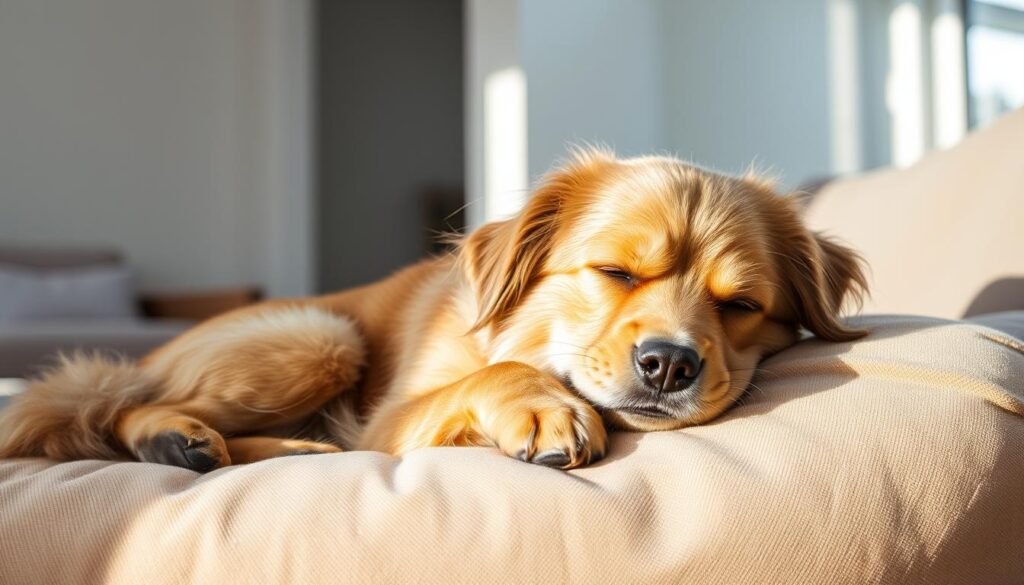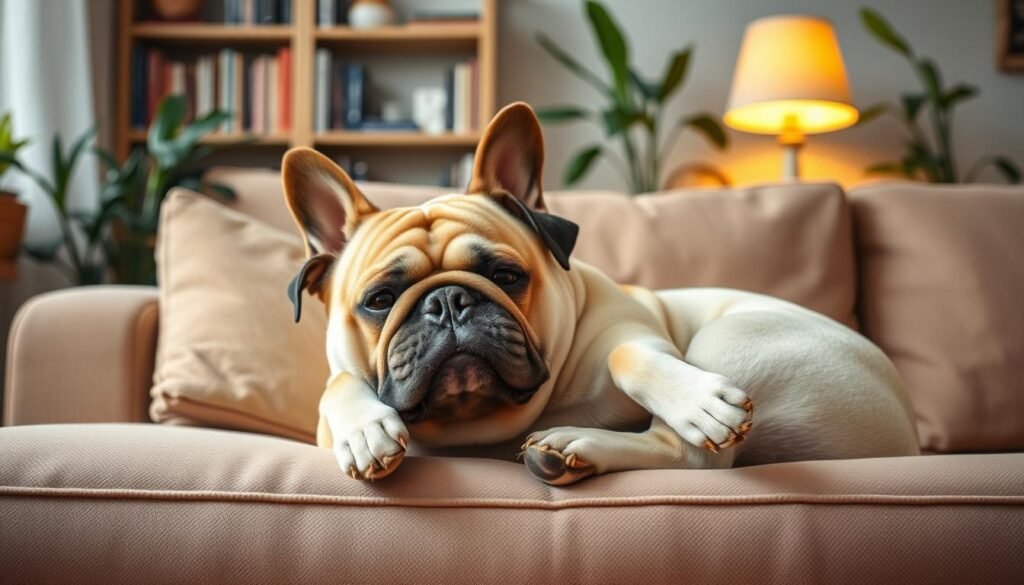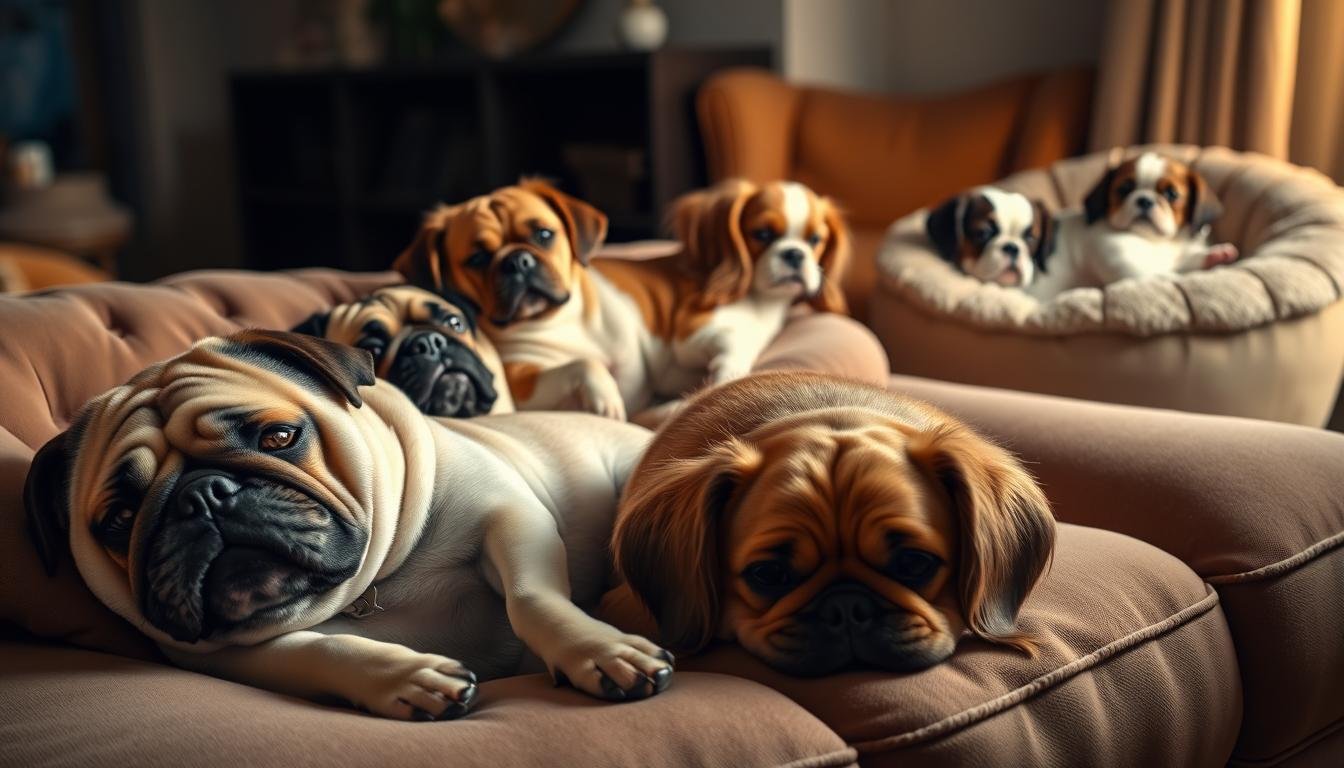Laziest Dog Breeds: Ideal Companions for Relaxed Lifestyles
Table of Contents
Are you looking for a furry friend that matches your relaxed lifestyle? You’re not alone. Many people want a low energy dog that doesn’t need a lot of exercise or training. Having a lazy dog can be very rewarding. They make great companions for those who love calm and serenity.
With a relaxed lifestyle, you can enjoy life’s simple joys with your dog. In this article, we’ll look at some of the most laid-back dog breeds. They’re perfect for those who want a loving but easy-to-care-for pet.
Why Consider a Low-Energy Canine Companion
Low-energy dogs are perfect for those who like a calm lifestyle. They’re great for people or families who don’t have time for lots of exercise. Or for those who just want to relax more.
What Defines a “Lazy” Dog Breed
A “lazy” dog breed has low energy and needs little exercise. Low energy dogs are not lazy; they just don’t need as much activity. This makes them perfect for apartments or homes with small yards.
Benefits of Owning a Low-Energy Dog
Owning a low maintenance dog has many benefits. Some of the main advantages are:
Less Exercise Requirements
Low energy dog breeds need less exercise. This means you can keep your dog healthy without spending hours exercising. Short walks and playtime are usually enough.
Lower Maintenance Needs
Lazy dog breeds need less grooming, which is great for busy owners. They might need less bathing, nail trimming, and brushing, depending on the breed.
Compatibility with Busy Lifestyles
For people with busy work schedules or who travel a lot, low maintenance dogs are ideal. They’re more okay with being alone and don’t get anxious when left alone like some high-energy breeds do.
Top 10 Laziest Dog Breeds for Cozy Living
If you’re looking for a furry friend that loves to relax, you’re in luck. These top 10 laziest dog are perfect for you.
These breeds are calm and don’t need much exercise. They’re great for those who like a relaxed lifestyle.
Bulldogs: The Ultimate Couch Potatoes
Bulldogs are known for being laid-back. They are calm and gentle, making them perfect for a relaxed home.
- Exercise Needs: Minimal
- Grooming Needs: Moderate
- Temperament: Affectionate, laid-back
Basset Hounds: Low-Slung Loungers
Basset Hounds are experts at being lazy. They love to lounge around, making them great for cozy homes.
Key Characteristics:
- Calm and patient
- Not overly demanding
- Adaptable to apartment living
Great Danes: Gentle Giants Who Love to Lounge
Great Danes are big but gentle. They love to lounge around the house.
They are calm and make great pets for families or individuals who want a low-maintenance friend.
Cavalier King Charles Spaniels: Adaptable Nappers
These spaniels are friendly and love to nap. They are adaptable, making them great for different homes.
They are perfect for those who want a loving and laid-back dog.
Shih Tzus: Lap Dogs Who Love Lounging
Shih Tzus are small and friendly. They love human company and lounging around.
They need little exercise and are very affectionate. They are ideal for those who want a low-maintenance pet.
Knowing about these breeds helps you choose the right lazy dog for your cozy home.
Small Lazy Dog Breeds Perfect for Apartments
Small lazy dog are great for apartment living. They are calm and don’t need much space. They’re perfect for those who want a pet but don’t have a lot of room or time for exercise.
Pugs: Small Dogs with Big Nap Needs
Pugs are known for their love of napping and being playful. They are a great fit for apartment living because of their laid-back nature.
Personality Traits
Pugs are loyal and loving companions. They love being around people and are often called “velcro dogs” because they stick close.
Care Requirements
Pugs need regular grooming to keep their fur from matting. They also need a balanced diet and regular vet visits to stay healthy.
French Bulldogs: Compact and Content
French Bulldogs are perfect for apartments because they are small and laid-back. They are adaptable and relatively low-maintenance.
Japanese Chin: Elegant and Easy-Going
The Japanese Chin is a gentle and quiet breed. They are intelligent and affectionate, making great companions for those who want a low-key pet.
Pekingese: Royal Loungers
Pekingese dogs are known for their calm and dignified nature. They are well-suited for apartment living because they don’t need much exercise and are quiet.
These small lazy dog breeds are the perfect choice for apartment dwellers. They offer a loving companion without the hassle of high-maintenance pets.
Medium-Sized Low-Energy Dog Breeds
You don’t need to be super active to have a dog. Medium-sized low-energy breeds are great for a calm lifestyle. They are calm, friendly, and easy to adapt to different homes.
Chow Chows: Independent and Inactive
Chow Chows are independent and don’t need much activity. They have thick coats that need regular grooming. But they are easy-going and don’t ask for much exercise.
English Bulldogs: Masters of Relaxation
English Bulldogs are all about relaxation. They are calm and don’t need much exercise. They make perfect pets for those who want a low-key but loving companion.
Chinese Shar-Pei: Wrinkled Relaxers
The Chinese Shar-Pei loves a relaxed life. Their unique looks and calm nature make them great friends for those who prefer a laid-back pet.
Clumber Spaniels: Calm Hunting Companions
Clumber Spaniels are calm and gentle. Even though they’re hunting dogs, they don’t need a lot of exercise. They’re happy with a bit of activity.
Here’s a comparison of these breeds based on key characteristics:
| Breed | Exercise Needs | Grooming Requirements | Temperament |
|---|---|---|---|
| Chow Chow | Low | High | Independent |
| English Bulldog | Low | Moderate | Affectionate |
| Chinese Shar-Pei | Moderate | High | Calm |
| Clumber Spaniel | Moderate | Moderate | Gentle |

When picking a medium-sized low-energy dog, think about their exercise needs, grooming, and personality. This ensures they fit well with your lifestyle.
Large Lazy Breeds for Spacious Homes
Big homes are perfect for big dogs. Some of the laziest breeds are quite large. If you have a big space, you might wonder which dog is right for you. These large lazy dogs are just as loving and loyal as active dogs but need less exercise.
Newfoundlands: Calm and Composed Companions
Newfoundlands are known for being gentle and calm. They are often called “nannies” because they’re patient with kids. They need daily walks but don’t need to run a lot.
Saint Bernards: Relaxed Mountain Dogs
Saint Bernards do well in big homes. They were bred for mountain rescue missions and are naturally calm. They like walks but don’t need to run a lot.
Mastiffs: Gentle Giants with Low Exercise Needs
Mastiffs are gentle giants that are laid-back. They need regular walks but don’t need a lot of exercise. Their calm nature makes them perfect for big homes.
Greyhounds: Surprising Couch Potatoes
Greyhounds are fast but love to relax. They are quiet, calm, and laid-back. They’re great for those who want a low-maintenance pet in a big home.
Some key traits of these large lazy breeds include:
- Low exercise needs
- Calm and composed nature
- Loyal and loving companionship
- Adaptability to spacious living environments
When picking a large lazy dog breed, think about your lifestyle and home. Make sure you can give them the best life.
Health Considerations for Sedentary Canines
Thinking about getting a lazy dog breed? It’s key to know about the health issues they face. These dogs, though calm and loving, can have specific health problems that need attention.
Managing Weight in Low-Activity Dogs
Keeping your dog’s weight in check is vital to avoid obesity-related health issues. This means proper diet planning and monitoring body condition.
Proper Diet Planning
A balanced diet is essential for your dog’s health. Talk to your vet to find the right food and feeding schedule.
Monitoring Body Condition
Check your dog’s body condition score often. This helps ensure they’re not too heavy or too light. Adjust their diet and exercise as needed.
Mental Stimulation Needs
Lazy dogs need mental stimulation to avoid boredom and stress. Use interactive toys and play to keep their minds sharp.
Exercise Requirements: Quality Over Quantity
Even though they’re lazy, these dogs need regular, gentle exercise. This helps keep them healthy.
Common Health Issues in Lazy Breeds
| Breed | Common Health Issues |
|---|---|
| Bulldogs | Respiratory problems, obesity |
| Basset Hounds | Ear infections, hip dysplasia |
| Great Danes | Cardiac issues, joint problems |

Matching Laziest Dog Breeds to Your Lifestyle
Lazy dog are perfect for many lifestyles. They suit seniors, busy professionals, and families well.
For Seniors and Retirees
Low maintenance dogs like Bulldogs and Cavalier King Charles Spaniels are great for seniors. They are gentle, loving, and don’t need much exercise.
For Busy Professionals
Busy professionals can enjoy a lazy dog breed that fits apartment living. French Bulldogs and Shih Tzus are ideal because they don’t need constant attention.
For Families with Children
Families with kids should choose a dog that’s lazy but also patient and gentle. Cavalier King Charles Spaniels and Basset Hounds are excellent choices. They’re good with kids and easy to care for.
For People with Limited Mobility
People with limited mobility need a low maintenance dog that’s easy to care for. Pugs and English Bulldogs are good because they don’t need much exercise and are happy with less activity.
When picking a lazy dog breed, think about your lifestyle, where you live, and how much care you can give. The table below shows some and which lifestyles they fit best.
| Breed | Ideal For | Exercise Needs |
|---|---|---|
| Bulldog | Seniors, Apartment Dwellers | Low |
| Cavalier King Charles Spaniel | Families, Seniors | Moderate |
| French Bulldog | Busy Professionals, Apartment Dwellers | Low |
| Basset Hound | Families, Those with Yards | Moderate |
Daily Care Tips for Low-Maintenance Dogs
To keep your low-maintenance dog happy, you need to know their daily needs. These dogs don’t need as much exercise as others. But, they still need regular care to stay healthy and happy.
Grooming Requirements by Breed
Grooming is key for many low-maintenance dog breeds. For example, Shih Tzus and Cavalier King Charles Spaniels need regular brushing. This prevents matting and keeps them looking great. Bulldogs, with their shorter coats, need less grooming.
Feeding Schedules and Nutrition
Feeding your dog a balanced diet is vital. A consistent feeding schedule keeps them energized and prevents overeating. Choose nutrition-rich dog food that fits their age, size, and breed. Larger breeds like Great Danes need more calories, while smaller breeds like Pugs need fewer but more often.
Creating the Perfect Lounging Environment
Creating a cozy lounging spot is crucial for lazy dog . Provide a comfy dog bed or crate with soft bedding.
“Dogs thrive on routine and comfort, so ensuring their resting areas are quiet, cozy, and free from drafts is important.”
Add their favorite toys or blankets to make their lounging spot even better.
Balancing Rest and Activity
Lazy dog breeds don’t need a lot of exercise. But, they still need some physical and mental stimulation. Short walks and playtime keep them physically fit. Interactive toys and puzzle feeders keep their minds sharp. Finding the right balance between rest and activity is key to their happiness and health.
Common Misconceptions About Low-Energy Dog Breeds
Many people think low-energy dog breeds are lazy or not smart. But this is not true.
Laziness vs. Health Issues
Some think low-energy dogs are lazy. But their calm nature often comes from their breed and genes, not laziness. These dogs are not built for high-energy activities. Their calmness can actually mean they’re healthy.
Activity Levels and Intelligence
Another myth is that low-energy dogs are less smart or harder to train. But being smart and trainable has nothing to do with energy levels. Many low-energy breeds are very intelligent and enjoy learning, needing mental challenges to stay happy.
Breed-Specific Needs Despite Low Energy
Low-energy dogs still need special care. They need regular grooming, a good diet, and mental games. Knowing their specific needs is key to their happiness.
Training Challenges and Solutions
Training low-energy dogs can be tricky, like keeping their attention. But with the right methods, it’s doable. Positive training and short, fun sessions can keep them interested and eager to learn.
By clearing up myths about low-energy dog breeds, we can better appreciate them. We can give them the love and care they need.
Conclusion: Finding Your Perfect Lazy Canine Companion
Exploring the laziest dog shows they can bring joy and comfort. They’re great for seniors, busy people, or anyone who loves a calm life. There’s a perfect lazy dog breed for you.
Knowing what these breeds need helps you choose the right one. Bulldogs are laid-back, while Great Danes are gentle giants. Each breed offers a special kind of friendship.
Having a low-energy dog means enjoying a calm life. You can spend quiet time with your pet. With proper care, your lazy dog will be happy and loving, without needing too much exercise.
When thinking about getting a lazy dog, remember they’re out there waiting for you. Choose a breed that fits your lifestyle. You’ll get a loyal friend who loves quiet moments with you.

